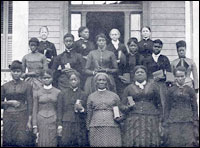Grant Boyhood Home and Grant Schoolhouse [OH]
The Grant Boyhood Home was the home of Ulysses S. Grant, 18th president of the United States, from 1823, when Grant was one year old, until 1839, when he left to attend West Point. Ulysses Grant lived in this home longer than any other during his lifetime. Jesse and Hanna Grant, the parents of young Hiram Ulysses Grant, built the original two-story brick section of the Grant Boyhood home in 1823, when they moved to Georgetown from Point Pleasant in Clermont County, where Ulysses had been born the year before. Grant attended the Schoolhouse from the ages of about six to 13. The building, built in 1829, consisted of only one room at that time.
The site offers tours.
